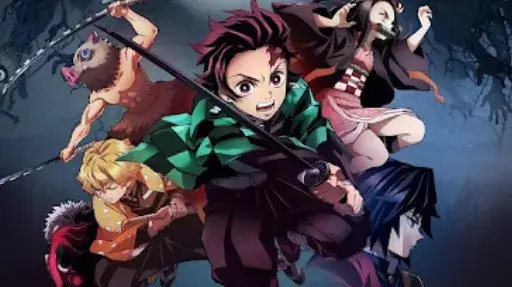Ten years ago, the idea of an anime film elbowing Marvel or Disney off the global box office charts sounded like a wild fantasy. Anime was respected, sure, but it wasn’t exactly the thing you expected to sit alongside billion-dollar blockbusters.
Then came Demon Slayer, swinging its sword through every expectation. Suddenly, packed theaters, emotional breakdowns in the audience, and record-breaking ticket sales became the norm. Anime wasn’t knocking on Hollywood’s door anymore; it was storming straight through it.
The latest juggernaut, Demon Slayer: Infinity Castle, isn’t just another success story. It’s proof that anime cinema is no longer a niche sideshow. The headlines can’t stop pointing it out, and neither can the industry folks running the numbers.
But one big question hangs over the cheering: Is this the future of anime at the movies? Are we looking at a path paved almost entirely by franchise films, or is there still room for original voices that don’t ride on the coattails of a TV hit?
That question has teeth. To answer it, we’ve got to rewind a bit, dig into the box office wars of the past, and look at how anime built its place in theaters in the first place.
The Box Office Arena
Numbers in cinema aren’t just about how many seats got filled. They shape what kind of films get made next. When Mugen Train smashed records in 2020, it wasn’t just impressive; it rattled the system.
This was a spinoff film that didn’t play it safe as a “bonus” side story. It became essential viewing and ended up outgrossing Hollywood releases during a time when theaters were struggling.
And once money talks that loudly, the industry listens. Suddenly, executives want the next “Mugen Train.” It becomes less about “is this story worth telling?” and more about “can this story guarantee an army of fans at the ticket counter?”
This tension between money and artistry has always been part of anime cinema. Hayao Miyazaki is proof of that. Today, his name sells itself; he’s the kind of director who has his own section in bookstores and museum exhibits.
But back in the early days, it wasn’t so simple. Castle of Cagliostro barely made a ripple, and even My Neighbor Totoro struggled in theaters despite being endlessly charming. Hard to believe, given Totoro’s face is now stamped across everything from lunch boxes to subway trains.
Miyazaki kept pushing. Then came Princess Mononoke and Spirited Away. Both changed everything. Suddenly, anime wasn’t just “cartoons from Japan.” It was a force capable of climbing the charts, competing with live-action epics, and winning Oscars. Spirited Away didn’t just dominate at home; it became the gold standard for anime films worldwide.
The kicker? It’s still up there in Japan’s all-time box office top three. Two decades later, it’s shoulder-to-shoulder with Demon Slayer. No franchise tie-in, no urgent must-watch for fans to keep up with a plot. Just an original, auteur-driven film that captured imaginations. That kind of staying power says a lot about the different routes anime can take.
When the Director’s Name Is the Brand
Anime has a funny way of turning directors into box office draws. Miyazaki is one, of course. Another is Makoto Shinkai, who rose from small, intimate projects to become one of the most bankable names in animation.
Shinkai’s beginnings were modest; shorts like Voices of a Distant Star reached niche audiences, often passed around through DVDs and word-of-mouth. His films looked gorgeous but weren’t built for giant crowds.
Then came Your Name in 2016. That film didn’t just succeed, it exploded. Suddenly, people were comparing him to Miyazaki, and his work was earning more overseas than anyone expected.
And the fascinating part? It wasn’t action-heavy spectacle that drove audiences in droves. It was a body-swapping romance about longing and connection. The fact that it overtook Spirited Away in global earnings showed that audiences are willing to rally behind a unique voice, not just a massive franchise.
Weathering With You and Suzume followed, each pulling impressive numbers and cementing Shinkai as more than a one-hit wonder.
So now anime has two proven paths to box office dominance: directors who can sell a ticket with just their name, and franchises that command armies of fans. Hollywood has directors too, of course, but anime’s balance between these two forces feels distinct.
IP Rules, but With a Twist
Of course, anime franchises remain monsters at the box office. But the way they operate is cleverer than the usual Hollywood sequel churn. Instead of optional side quests, these films often hold pieces of the main story hostage.
If you skip Mugen Train, you miss a vital arc. If you miss Infinity Castle, you’ll be lost when the TV series resumes. Fans don’t just want to watch, they need to.
That sense of urgency is why theaters see groups of teens and families lining up in Japan, and why international fans organize watch parties abroad. You’re not just watching a movie; you’re participating in a cultural checkpoint.
The formula works for more than just Demon Slayer. One Piece Film: Red leaned on the franchise’s massive reach and brought in pop star Ado to expand its draw. The First Slam Dunk surprised many by pulling sports drama back into theaters, proving nostalgia and heartfelt storytelling still move people.
The Detective Conan films, released annually, are practically guaranteed hits now, drawing both families and lifelong fans. Even Jujutsu Kaisen 0 became an essential prequel that filled in backstory fans didn’t want to miss.
Unlike Hollywood spin-offs that often feel like afterthoughts, these anime blockbusters are built as vital pieces of the puzzle. Skipping them feels like missing a season finale.
The Rankings Don’t Lie
Japan’s box office charts tell the story better than anyone could. The top slots belong to Demon Slayer, but right there in the mix are Your Name and Spirited Away. It’s a cocktail of franchise giants and auteur masterpieces. That duality is what makes anime so fascinating at the movies; it’s not one formula ruling them all.
Even flops in reputation can turn into hits at the box office when tied to a trusted brand. Studio Ghibli’s Tales from Earthsea wasn’t exactly beloved, but it still cracked into top rankings thanks to the Ghibli name. Meanwhile, Totoro, which bombed at first, only reached towering earnings decades later after being re-released abroad.
When you zoom out, the numbers show two engines powering anime cinema: big-name auteurs and franchise loyalty. Both lanes are thriving.
Competition From Abroad
It’s not just Japan pushing boundaries. China has muscled into the animated box office conversation with some record-shattering hits. Ne Zha 2 crossed the $2 billion mark globally, built on a character rooted in centuries of folklore. That kind of pre-loaded cultural recognition works just like Spider-Man does in the West. Audiences show up because they already know the hero.
Then there’s Nobody, a hand-drawn film that managed to earn over $200 million in a market that loves shiny CG. It even outperformed some Hollywood entries like Pixar’s Elio. It’s a reminder that audiences everywhere are ready to support diverse stories, not just the safe bets.
For anime, that means competition is real. Demon Slayer might be king for now, but international rivals prove that audiences are open to fresh flavors in animated cinema.
What It All Signals
So, where does this leave anime cinema? Right in the middle of a tug-of-war. On one side, you’ve got serialized blockbusters designed to keep fans locked in. On the other hand, original visions from auteurs who build their own followings. Both are thriving, and both are shaping the future.
Studios are taking notes. Expect more serialized films tied directly to TV shows. Expect bold original projects too, because history has shown they can break through when the timing is right. Maybe we’ll even see hybrids, franchise films infused with auteur touches, or auteur projects marketed with franchise-style hype.
For anyone working in storytelling today, these shifts matter. The methods anime uses, tight storytelling, emotional weight, striking visuals, don’t stay in one industry. They ripple outward.
That’s why you see them influencing other creative fields, even areas like 3D animation services, where the challenge is to keep audiences engaged in completely different ways.
Streaming’s Complicated Relationship with Theaters
It’s impossible to talk about anime cinema today without bringing up streaming. For years, platforms like Netflix, Crunchyroll, and Amazon Prime were seen as the saviors of international anime distribution.
Suddenly, fans outside Japan didn’t have to hunt down grainy DVD imports or wait for sketchy fan-subs. The content was right there, neatly subtitled, available in multiple languages.
But there’s a twist. While streaming opened the gates, it didn’t kill the theatrical experience. In fact, the opposite happened. When fans binge a show at home and then hear the story continues in a movie, they don’t hesitate to buy a ticket. Instead of replacing theaters, streaming ended up priming audiences for them.
Take Jujutsu Kaisen 0. Crunchyroll helped build a massive international base for the series. When the movie dropped, that same base flooded cinemas. The two ecosystems are feeding each other. Fans invest time in a show online, then treat the film release like a victory lap.
For studios, this is gold. It means they can count on fans showing up for both. But it also means the pressure is high, fumble a story arc in theaters, and you risk souring the goodwill that streaming built.
Hollywood Is Watching Closely
It’d be naïve to think Hollywood isn’t taking notes. Anime’s playbook of serialized storytelling that extends into theaters is basically what Marvel has been trying to do for a decade. The difference is that anime still feels fresher. Fans aren’t yet burned out by endless reboots or the dreaded “shared universe fatigue.”
Look at Marvel’s most recent stumbles. Audiences are skipping titles because they don’t want homework just to understand the next installment. Anime flips that script; people want the homework. They crave those extra pieces, and they celebrate filling in the gaps with their friends. It’s a different energy, built not on obligation but on excitement.
The trick for Hollywood is figuring out how to replicate that without overplaying it. And right now, anime has the upper hand because it’s not afraid to blend high-stakes storytelling with raw emotion.
Demon Slayer doesn’t just give you fights; it makes you cry. Your Name doesn’t just romance you; it devastates you. That emotional authenticity is something Hollywood blockbusters have often been accused of lacking.
The Fans Call the Shots
If there’s a lesson in all of this, it’s that anime cinema is being shaped less by executives and more by fans. Studios can only greenlight what they think will sell, but it’s the audiences filling seats that prove what really matters. And anime fans? They’re vocal, organized, and ready to put their money where their passion lies.
Fan events are part of the reason anime dominates theaters. Look at the themed screenings, the cosplay meet-ups, the collective sobbing sessions during big finales. These aren’t passive viewers, they’re communities. Hollywood premieres feel like marketing events. Anime premieres feel like cultural gatherings.
The success of The First Slam Dunk is a great example. On paper, reviving a ’90s sports manga for a modern audience sounds risky. But nostalgia mixed with genuine love from fans turned it into a phenomenon. It wasn’t just older audiences returning; it was new ones discovering what the fuss was about.
That’s the unpredictable power of fandom: they can breathe life into projects that executives might otherwise ignore.
Auteurs vs. Franchises: Who Really Wins?
So, back to the big debate: is anime cinema dominated by auteurs or franchises? The truth is, both have their wins and losses. Franchises guarantee numbers but can get repetitive. Auteurs bring originality but carry financial risk.
But maybe that’s the wrong way to frame it. Instead of asking who “wins,” it’s more interesting to ask how they coexist. Right now, they feed off each other. The huge popularity of franchise films keeps theaters interested in anime.
That same spotlight gives auteurs the room to pitch their visions. And when auteurs succeed, they elevate the reputation of anime as “art,” which in turn makes casual viewers more willing to check out franchise projects.
It’s a cycle. And unlike Hollywood, where original blockbusters are nearly extinct, anime still balances both.
The Global Stage: Not Just East vs. West
We can’t ignore how international anime’s appeal has become. It’s no longer a “Japanese export.” It’s a cultural powerhouse shaping global trends. You’ll find Demon Slayer posters in Mexico, Your Name references in France, and Naruto tattoos in every corner of the internet.
Meanwhile, China’s animation surge is pushing the competition harder. And in South Korea, smaller projects are quietly gaining traction, experimenting with styles that don’t look like the typical anime mold but still draw influence from it.
The global animation scene is starting to feel like a dialogue, not a rivalry. Each region raises the bar, and the others respond. For audiences, that means more variety. For studios, it means constant pressure not to get complacent.
The Closing Scene
So, where does anime stand in the battle for the big screen? In a surprisingly strong position. It’s not just clinging to a niche; it’s setting the pace. Franchises prove that loyalty can move mountains. Auteurs prove that originality can still spark global phenomena.
Together, they’ve carved out a presence that Hollywood has to respect, not just as competition but as inspiration.
The next few years will tell us if the balance holds or if one side tips the scales. But right now? Anime is enjoying a moment most industries would envy. Fans are engaged, theaters are packed, and the headlines keep coming.
Anime isn’t just surviving in the age of blockbusters. It’s redefining what a blockbuster can be.







